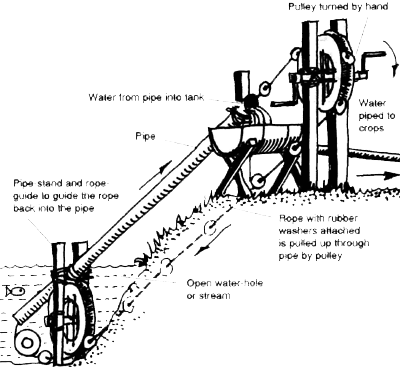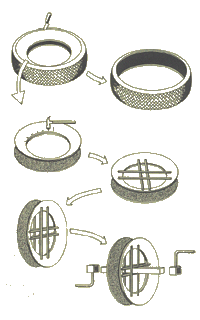by Robert Lambert.
Lifting and carrying water in buckets or cans to irrigate crops is very hard work and can take a lot of time. In Zimbabwe, some families spend up to 200 hours per month on this exhausting job. This can mean three to four hours every day for two or three people in the family. The only alternative presently available is a diesel or petrol pump - out of reach of most small farmers because of the high cost, the problems in obtaining fuel and spare parts and the need to have a lot of land to justify such a large investment.
A solution?
To deal with this problem, simple pumps for garden irrigation have been developed under a research project funded by the Overseas Development Administration and based at Loughborough University of Technology and the University of Zimbabwe. These pumps are now being used by farmers in many parts of Zimbabwe. In some cases the pumps are made by village pump-makers who have been trained in how to make them. The farmer pays for the pump and the pump-maker installs the pump at the farmer’s well. This has the advantage of creating jobs for pump-makers and ensuring that the farmer knows who to turn to if there is a problem. In other cases farmers have been shown how to make their own pumps.
Pumps for lifting - Pipes for carrying
A pump can only lift the water from a low point, such as a well or river, to a high point, such as a tank on the ground. An old 200 litre drum is ideal as a tank. The water must then be taken to the crops. Plastic hose piping is a very effective way of doing this. This will save the effort of walking to and from the well.
What do such pumps cost?
One of the simplest and most effective pumps that can be made cheaply is the rope-washer pump. Historically the principle is very old, having been used in Roman times, but it has been adapted to use materials which are now widely available and cheap. For example, in Zimbabwe, with all materials bought at shop prices, the cost of the materials amounts to about Z$70.00 (about UK £15.00). Some farmers have made the pump for less than Z$20.00 (UK £4.00) by using materials available on their own farms.
The rope-washer pump can:
- lift water from open waterholes, hand-dug wells and streams but not from narrow machine-drilled boreholes.
- pump up water very quickly when the water is near the surface. A number of farmers in Zimbabwe have made pumps that can fill a 200 litre drum in one minute. Of course, at the end of that minute you would be quite tired! You can have a rest while the water empties from the drum through a pipe onto the vegetable beds.
- lift water from deep wells. Water has been lifted from depths of more than 20 metres. However, in deeper wells, water flows from the pump more slowly because it is harder work.
- lift water into overhead tanks.
- be operated by one or two people at a time.
- cope easily with mud, weeds, etc.
- be easily understood and repaired by the farmer when something goes wrong.
What size garden can be irrigated in this way?
As an example, an area of 0.1 hectares (a little over 30m x 30m) would take about six hours per week to irrigate, or a little over an hour a day, if pumping up water from a 5 metre-deep well. To irrigate such a garden with a watering can would take at least four hours each day.
How does it work?
The pump consists of a continuous rope, with rubber washers attached, which is pulled up through a pipe by means of a pulley-wheel. The rubber washers are slightly smaller than the inside of the pipe. When the bottom of the pipe is inserted in water, the rubber washers, moving upwards, draw the water with them. As they emerge at the top of the pipe, the water falls into a collecting tank.
What materials are needed?
Pipe, rope and an old tyre are the most important materials. Where available, strong PVC pipe is ideal. Steel pipe may also be used. If piping is unavailable then a square pipe may be made out of wooden boards. Strong water-resistant rope, such as nylon braid, is the best, although ropes made of sisal, manila or even strips of car tyre may be used. Steel bars, strips of inner tube, some poles, wire and nails are also required.
A sharp knife, a hammer, a pair of pliers, a wood-saw and wood chisel and a hack-saw are all the tools required. Although not required, basic welding facilities can improve the quality of the handle.
An experienced pump-maker, with all the materials ready, can make and install the pump in one day.
Training and extension
In order to make this technology widely available, good training is required. A detailed manual has been published in English, on the construction of the rope-washer pump. A 20-minute video is available, showing the main steps in making the pump. There is no narrative, so this can be used whatever the local language.
Both are available from: Intermediate Technology Publications, 103 Southampton Row, London, WC1 4HH, UK.
Training in the construction of the pump is only the first step. Training in garden irrigation for farmers, and in business methods for pump-makers, would also be useful. A number of such courses have already been run in Zimbabwe and more are planned in other countries such as Kenya. For details of such courses and further information about the rope-washer and other simple irrigation pumps please write to:
Robert Lambert, School of Development Studies, UEA, Norwich, NR4 7TJ, UK.
Robert Lambert comes from a farming background and has worked with rural water supplies in Tanzania, Zambia and Zimbabwe. He is at present lecturing in Development Studies at the University of East Anglia.
Making the rope-washer pump









